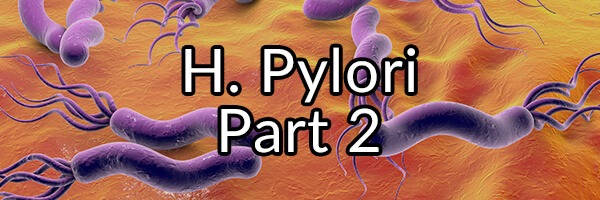More and more people are contacting me with H. pylori overgrowth. Some just have symptoms of overgrowth; others have tested positive for the bacteria.
One person I coached had multiple H. pylori tests done; they kept coming back negative. Even though this person had a prior infection, still had the symptoms of a reinfection, and responded to antimicrobial agents that target the bacteria.
Finally, after the third biopsy, H. pylori was confirmed that it had reared its ugly head and was the cause of their symptoms as I had believed. How can this be?
Why is it so hard to test for H. pylori sometimes? What does the difficulty in the testing for this bacteria have to do with rather or not it is friend or foe?
H. pylori The Hobo Bacteria
H. pylori can become normal or opportunistic flora in three or more different parts of the human body. The mouth, the stomach, and the duodenum are known as the big three parts of the body that it colonizes. H. pylori is a transient bacteria; that can move freely in different parts of the body if kept unchecked. 1 2 3
So what does H. pylori being transient have to do with whether or not it is friend or foe? Well, studies have indicated that depending on what area of the stomach and duodenum H. pylori is currently colonized at the time, the greater the chance it is normal flora or the cause of your digestive woes. 4
There are four main areas in the stomach; they include from the LES down to the duodenum: 5
- Cardia – the part of the stomach where the esophagus empties into the stomach. The LES is located here.
- Fundus – the top part of the stomach.
- Body – the largest part of the stomach, the middle.
- Pylorus – the lower part of the stomach that is attached to the duodenum by the pyloric sphincter. The pylorus is broken up into two parts the pyloric antrum and the pyloric canal.
Now depending where the bacteria are colonized within the stomach the greater chance it is either normal flora or opportunistic.
H. pylori opportunistic colonization of the mouth has been linked to possibly being the cause of the auto-immune conditions Sjogren’s syndrome and burning mouth syndrome. There are mixed studies about it being the cause, but that being said concerns have been raised in the studies finding none or small amounts of correlation between the two, that the bacteria is transient and can be very difficult to biopsy. It has also been theorized that H. pylori can colonize the esophagus, depending on the cell structure of one’s esophagus. 6 7
Cardia dominant colonization of the bacteria is associated with increased risk of developing cancer in that region of the stomach. Paradoxically, H. pylori dominant cardia colonization is not linked to increased GERD symptoms, which makes less sense to me because I believe that gastritis in that area should weaken the LES and increased pressure in the stomach because of the overgrowth should cause more reflux symptoms. Furthermore, it would appear that H. pylori colonization of the cardia also coincides with the colonization of the pyloric area of the stomach, which should further increase one’s chances of suffering from GERD. The theory of dual colonization is based on the fact that in cardia colonization, inflammation and gastritis increase in the pyloric areas and does not occur within the body of the stomach. It is possible that this could occur however from unknown hormonal changes of the gastrointestinal system (modifying digestive hormones) by cardia overgrowth instead of dual colonization. 8 9
Body dominant colonization of H. pylori reduces your chances of having GERD (esophageal inflammation) by reducing stomach acid production. That being said it appears that a body dominant H. pylori colonization is greater linked to the development of gastric ulcers and stomach cancer. It is truly a catch-22, you might have a less chance of having acid reflux, but greater chances of developing gastritis, gastric atrophy, ulcers, and stomach cancer. 10
Pyloric dominant colonization of H. pylori has a set of different symptoms. Pyloric colonization seems to spread to the duodenum and seems to cause pre-pyloric and duodenal ulcers. GERD may develop as well from increased gastrin production (impairment of local somatostatin release,) causing up-regulation of stomach acid and increased localized pressure from H. pylori overgrowth. 11
It does, however, appear that an equal colonization of both parts of the stomach by the bacteria appear to be asymptomatic, coincide with no reduction in stomach acid, and are believed to be linked to the bacteria being considered “normal” flora. It also appears that single colonization of one strain, like H. pylori cagA+, for example, might lead to it being normal flora, instead of multiple co-colonization or co-infections of multiple strains. H. pylori may be one instance where microbiome diversity of a specific strain might be a bad thing for your gastrointestinal health. 12 13 14
The transient nature of the bacteria and being able to embed itself deeply within the mucosal barrier and avoid immune system detection is why it can be so hard to biopsy accurately. This causes issues for accurate studies and diagnosis of opportunistic bacteria to help further understand the nature of H. pylori and in being able to help people who are made ill by an overgrowth of this gram-negative bacteria. 15
There is so much we do not know about the bacteria or our microbiome as a whole. We will continue learning about this fascinating bacteria together in part three, which will be on the perils of opportunistic H. pylori.
See more from this series:
- H. pylori, Evil Mastermind or Ally? / Part 1
- H. pylori, Evil Mastermind or Ally? / Part 2
- H. pylori, Evil Mastermind or Ally? / Part 3
- http://www.ncbi.nlm.nih.gov/books/NBK2437/ ↩
- http://www.ncbi.nlm.nih.gov/pmc/articles/PMC1539101/ ↩
- http://www.ncbi.nlm.nih.gov/pubmed/11555160 ↩
- http://www.nature.com/articles/srep00994 ↩
- http://www.theodora.com/anatomy/the_stomach.html ↩
- http://www.ncbi.nlm.nih.gov/pmc/articles/PMC3643302/ ↩
- https://www.hon.ch/OESO/books/Vol_3_Eso_Mucosa/Articles/ART219.HTML ↩
- http://www.ncbi.nlm.nih.gov/pubmed/21184266 ↩
- http://gut.bmj.com/content/54/suppl_1/i13.full ↩
- http://digestivehealthinstitute.org/2014/07/10/h-pylori-low-stomach-acid-gerd/ ↩
- http://digestivehealthinstitute.org/2014/07/10/h-pylori-low-stomach-acid-gerd/ ↩
- http://digestivehealthinstitute.org/2014/07/10/h-pylori-low-stomach-acid-gerd/ ↩
- http://www.ncbi.nlm.nih.gov/pmc/articles/PMC3921471/ ↩
- http://www.ncbi.nlm.nih.gov/pubmed/25827337 ↩
- http://www.ncbi.nlm.nih.gov/pmc/articles/PMC4293485/ ↩







PyloPass, specifically created to treat H Pylori and not affect other microbes. It binds to h pylori and escorts it out. It is in Life Extension’s GastroEase:
https://www.youtube.com/watch?v=rs6UUplb0oA&t=65s
Helicobacter pylori infection is associated with high methane production during lactulose breath test
https://www.ncbi.nlm.nih.gov/pubmed/27608906
” CONCLUSIONS: This study shows for the first time, a significant association between H. pylori infection and methane production, suggesting that H. pylori might influence gut microbiota composition.”
https://www.ncbi.nlm.nih.gov/pubmed/30302165
“Small intestinal bacterial overgrowth (SIBO) may coexist with Helicobacter pylori infection, which can be the cause of chronic gastrointestinal complaints.”
Functional 13C-urea and glucose hydrogen/methane breath tests reveal significant association of small intestinal bacterial overgrowth in individuals with active Helicobacter pylori infection
https://www.ncbi.nlm.nih.gov/pubmed/27586816
H. Pylori, is not all bad – as you mention. I currently have biopsy confirmation of h. pylori along with esophagitis because of reflux. I am experimenting with keeping the h pylori because it’s been found to be protective against progression to Barrett’s esophagus. I’m not totally against getting rid of it – but have read that getting rid of it can increase GERD further.
Why use triple antibiotic therapy when there are natural protocols like mastic gum and DGL? There are many natural products on the market for h pylori like Pyloricil and Designs for Health Gastroment-HP. Also matula tea. David Hompes and other practitioners mention them along with diet.
I recently started Betaine HCI with Pepsin after coming off Omperazole for 2.5 years for reflux. I have now been off of it for about 2 weeks. I have experimented with 1-3 tablets (the max dose according to the bottle I bought. I dont think I feel any warming from it. I am now trying 3 capsules with meals but I am still getting bad heartburn 2 – 3 hours after eating. Im confused if the heartburn is the warning to not take the HCL or if it means I am not taking enough.
https://fixyourgut.com/betaine-hcl-does-it-help-digestion/
are stool tests any good?
For H. Pylori, the standard stool antigen test is probably not worth it. DRG might have the best stool test, but it is not perfect: https://drglab.com/h-pylori-eradication-profile/.
Thanks for sharing the articles.
I’ve been having H Pylori for more than 1 year, tried all the possible natural remedies/botanicals/antimicrobials without luck, stool test still positive.
My only symptom is bloating on the lower belly. Do you think that could be caused by H Pylori given that it normally resides in the stomach area?
Yes, might need to try triple antibiotic therapy and correct your possible low stomach acid to see if it can reduce populations enough to not cause issues. You could also be suffering from unrelated overgrowth in the intestines causing issues.
thanks I also believe there are other parasites other than pylori, will have to run more test.
In regard of Pylori though, I understand it can cause bloating, but how can that happen given that it lives in the stomach?
It reduces protein assimilation which can be fermented by other bacteria later on.
In regard of the locations of H pylori you mentioned, is there a way to detect where it lives?
I took 6 capsules 2xdaily before/with meals of HCL+pepsin (Thorne) for about 50 days. Only in one instance I had the burning/heat feeling. So I assumed I had/have low stomach acid
It is hard to determine where it lives. It would take multiple biopsies of different areas of the stomach and duodenum and even then you may not find it. It is easier if you have an ulcer and an active infection.
just had a Helico. Pylori Breath tst and it found no units at all.
does it basically mean nothing in terms of whether im infected or not?
thanks
No, it just means you are not suffering from an active overgrowth within the stomach, you can still be infected.